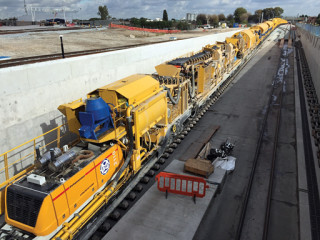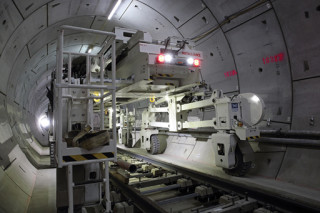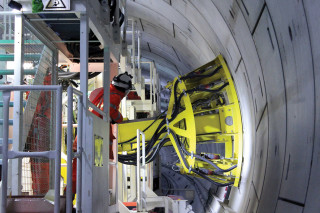For most people, Crossrail still means tunnels, and for good reason. Driving more than 40km of new tunnel under the capital has been a remarkable feat of engineering, as has the task of removing the five million or so tonnes of muck arising from the operation.
But although the tunnelling work is now complete, there remains plenty to do before the line – to be dubbed the Elizabeth Line – opens in December 2018.
In 2013 Crossrail chief executive Andrew Wolstenholme announced the award of the project’s last major construction contract – contract C610: the £300m tunnel fit-out package - to ATC, a joint venture comprising French rail specialists Alstom Transport and Transports Sud Ouest (TSO), and British contractor Costain.
ATC’s contract involves the installation of track, tunnel ventilation, high-voltage power, traction power, signalling, communications and overhead line equipment. For this, the contractor is deploying a fleet of specially-designed machines and vehicles including four large multi-purpose gantries to carry the track components into position within the tunnels.
The work is being directed from two logistics centres, one at Plumstead in south-east London, the other at Westbourne Park in west London. Plumstead, the larger of the two, has an eight-track railhead and is equipped with an overhead gantry crane to handle heavy and bulky items, such as sleepers and rail sections.
The Westbourne Park railhead was used during the tunnelling phase of the project as the removal point for material excavated from the western tunnels. During the fit-out phase, it provides a three-track railhead from which equipment and materials stored at the Old Oak Common depot are delivered to the western tunnels.
Several different track designs are being installed. Around 80% of the track – just over 41km - is a standard track slab design with the rails fixed to sleepers on a bed of fibre-reinforced concrete. But in the 135-year-old, 550m long Connaught Tunnel, which runs below the Royal Docks next to the Excel exhibition centre, direct fixed track is being installed.
Here, the rails are fixed directly to a new reinforced concrete bed cast into the invert of the old Victorian railway tunnel, which has been deepened, widened and strengthened to accept the new Crossrail trains.
In particularly sensitive stretches of the central section – principally between Bond Street and Tottenham Court Road and between Farringdon and Barbican - special “floating” track is being installed to minimise the risk of noise and vibration being transferred to basement recording studios in the Soho area and to the Barbican concert hall further east.
The floating track is constructed by casting the slab in 50m-long sections over a debonding agent applied to the base slab of the tunnel. When cured, the track slab is then lifted with hydraulic jacks and a combination of EPDM rubber bearings and heavy-duty springs is installed underneath it. Two versions of this system are being installed: approximately 2km of “light” floating track in the West End and about 1.34km of “heavy” floating track in the section running under the Barbican.
To further reduce vibration, and to accommodate the extra depth added by the spring bearings, shallower sleepers made with a special high-density concrete mix, called Magnadense, are used. Developed by Swedish minerals group LKAB, Magnadense is an aggregate product made from magnetite iron ore that can be used to produce mixes with up to twice the density of standard 30N concrete.
Concrete for the majority of the track slab is produced on a 465m-long concreting train, described by Crossrail as “a sophisticated mobile underground concrete batching factory”. The train was procured in France where it was refurbished before being brought to the UK through the Channel Tunnel in August 2015. Based at Plumstead, the concreting train, which runs on temporary track laid in the tunnels, is capable of installing up to 250m of concrete track slab per day. When not in use, the train is split in two and shunted into two of the eight railhead tracks.

Concrete for the western tunnel track slabs (between Royal Oak and central London) is batched at Paddington New Yard and loaded onto a concreting shuttle which was delivered to Westbourne Park in January.
The steel rails are manufactured by British Steel – the appropriately renamed former Tata Steel Long Products Division in Scunthorpe. The business which was bought in April by a management team backed by venture capitalist Greybull Capital.
The Scunthorpe works produces the raw steel which is then rolled at the company’s mill in Havange, north-east France, before being delivered back to the Plumstead railhead via the North Kent Line.
The concrete sleepers - around 70,000 of them – are made by precast manufacturer Stanton Bonna in Nottingham and are delivered in batches to Plumstead and Westbourne Park. The four multi-purpose gantries are designed to travel over the flatbed rail wagons carrying the sleepers, pick them up and carry them into the tunnel.
Special vehicles

The initial sequence of work for installing the track slab is carried out by four multi-purpose gantries which transport and position the precast concrete sleepers and steel rail sections in Crossrail’s central section. Each gantry, operated by a single person, will run along the raised curbed sides of the tunnel’s first-stage concrete.
After positioning 108m-long sections of rail along a stretch of tunnel, the gantry then delivers sleepers at carefully measured intervals, before lifting the rail into place on top of them. The track is then secured in place using clips, props and jigs before it is welded and the formation concreted into position.
Two gantries operate from Plumstead, one from Westbourne Park and the other is installing the floating track slab underneath the Barbican.
The bespoke gantries have been manufactured for Crossrail by Metalliance in France and were delivered to London in August 2015.
To drill the 250,000 holes needed for the installation of cabling brackets, walkways and other equipment within the tunnels, ATC joint venture is using a specially-built automated drilling rig manufactured by Swiss firm Rowa Tunnelling Logistics.
Once the track slab has been laid, the rig runs along the track, drilling the holes in pre-determined locations. The machine has a dust suppression system in place, and produces a clean and accurate hole every time. The drilling rig works in conjunction with 3D laser survey equipment to ensure accuracy.
Power and communications
Traction power for the Crossrail trains will be provided by a 25kV overhead line carried on a catenary system inside the tunnels. Two new bulk supply points, provided by National Grid at Pudding Mill Lane in the east and Kensal Green in the west, deliver power for the central section.
A 22kV high-voltage network will be installed in the central section from Royal Oak Portal in the west to Limmo Peninsula in the east. An 11kV high- voltage non-traction spur installed from Limmo through to Plumstead will supply mains power to each Crossrail station, shaft and portal within the central section.
The new Elizabeth Line will employ a communications-based train control (CBTC) signalling system, as used by many metro systems around the world.
The system will incorporate:
• Customer information systems - customer information displays in ticket halls and concourses and at each platform screen door
• CCTV - digital cameras for station control and security. Camera views of the platform are transmitted to the driver’s cab for driver-only operation (DOO)
• Radio - provision of radio infrastructure/network for operations and emergency services
• Public address system - for general and emergency announcements.
Crossrail will initially operate 24 trains per hour in both directions in the central section. The signalling system, which incorporates automatic train operation (ATO) will be capable of upgrading to over 30 trains per hour at a later date.
To permit integration with the existing National Rail network, Crossrail services will need to operate with existing signalling and safety systems installed at either end of the Crossrail tunnels.
Got a story? Email news@theconstructionindex.co.uk




